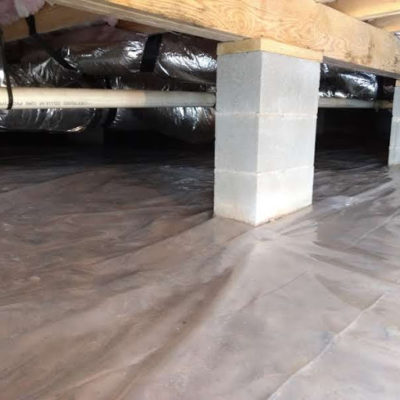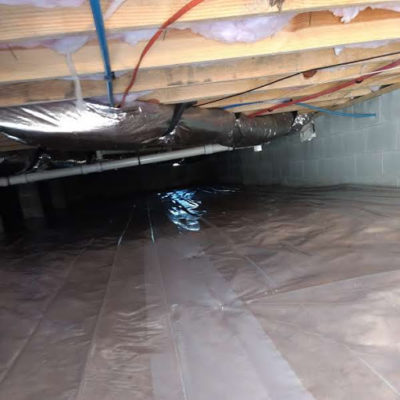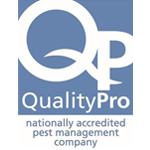Vapor Barriers in Charlotte, NC
Did you know that controlling moisture can save you money by moderating temperatures and making your home more energy efficient? Additionally, it will be more comfortable and deter the growth of mold in often-neglected areas of your home. Luckily there are many moisture-control products and services on the market that can help your home and your wallet. One of these solutions is a vapor barrier, also known as a vapor diffusion retarder.
Free Moisture Control Inspection
How to Identify a Moisture Problem

If you’ve frequently experienced water problems in the past, you may need a moisture barrier to stop or prevent your reoccurring moisture problem. Similarly, if you’ve had frequent issues with pest infestations, that may also signal a moisture problem requiring a vapor barrier.
If you’re not sure whether you need a vapor barrier, hire an experienced pro like Carolina Pest. One of our trained technicians will go to your home in the greater Charlotte area to see if a vapor barrier is the right solution for you.
Vapor barriers can help your home stay dry by reducing the water permeability of the space. At Carolina Pest Management, we have seen the need for moisture control with our Charlotte clients and we provide those services to cover your home’s needs!
- Signs of rust
- Standing water
- Rotting wood
- Mold or mildew
- A foul odor that is affecting the rest of your house
- Pest infestations
- Parts of your house are water damaged, either from excessive moisture in your crawl space or from condensation inside your home
Benefits of Installing a Vapor Barrier
When installed correctly, vapor barriers provide many benefits to homeowners. They’re especially important for preventing mold, rot, mildew and pest infestation. Here’s what you need to know.
Control Temperature & Save Energy
Vapor barriers work in partnership with insulation to control the temperature in your home. Installation of a vapor barrier and proper insulation can help keep temperatures throughout your home even and under your control. This helps save energy spent on cooling and heating your home at times of the year when temperatures are extreme, which in turn can reduce your home’s utility bills.
Limit Moisture Inside Your Home
Crawl spaces can be damp places, full of moisture. Over time, that moisture can find its way into your home. A vapor barrier installed in the crawl space can prevent this type of moisture transfer, which can protect your home from problems like condensation on the walls, excessive humidity indoors and poor indoor air quality. If your crawl space has standing water, frequent puddles and high humidity, this is a sign that you need a vapor barrier installed in your crawl space.
Protect Your Pipes and Home Electrical Systems
Excessive moisture in the air can be damaging to your pipes and home electrical systems, causing parts of them to degrade over time. In addition, since moisture can open the door for structural damage and pest infestation, chewed wires and other problems can be the result. Vapor barriers provide protection for these systems and prevent this kind of damage from occurring.
Preserve Your Home’s Foundation and Structure
Moisture in the home can cause wood rot, mold and mildew, which in turn can lead to structural problems and foundation trouble. Installing a vapor barrier, if the work is done correctly, can protect your home’s structure, saving you hundreds or thousands of dollars in repairs over time.
Prevent Pest Infestation
Pests take advantage of structural weaknesses. Some rodents will chew through rotten wood, while many wood-eating pests prefer rotten wood because it is easier to compromise. Installing a vapor barrier in your home can prevent this kind of structural damage, which in turn can deter pests, prompting them to find another suitable place to go.
Low Maintenance
Vapor barriers require minimal upkeep and can last up to 20 years, although it’s always a good idea to inspects them every 2-10 years.
Our Moisture Inspection Process
We’ll do a complete inspection around your house and depending on the type of problem, we’ll recommend a solution that meets your unique needs and budget. We often recommend using a vapor barrier in your crawlspace to keep moisture in the soil from being absorbed by your home’s foundation. It’s also a good idea to control moisture with a vapor barrier where you have piping, to avoid potential rust or damage.
Moisture Control Treatment: Vapor Barrier

The vapor barrier is manually installed by our technicians to prevent ground moisture from rising to the substructure. There are different types of vapor barriers based on units of permeability (the ability for liquids or gas to pass through a material), known as perms. We can help analyze your situation and will install the proper vapor barrier to fulfill your home’s moisture control needs.
There are many different types of vapor barrier materials, including
-Aluminum foil
-Metalized film
-Elastomeric coatings
-Paper-backed aluminum
-Vapor retarder paints
-Sheet-type roofing membranes
-Extruded polystyrene
-Exterior grade plywood
Crawl space vapor barriers range in thickness. The thinnest barriers are 6 millimeters, while the thickest are as thick as 20 millimeters. Higher numbers correspond to thicker barriers.
Thin barriers are not always as effective for vapor control purposes, as they can be more easily torn, leading to longer-term problems with vapor control. However, an experienced professional will be able to tell you what kind of vapor barrier is best for your home.
Vapor Barrier Maintenance
Vapor barriers require minimal upkeep. If you discover that moisture has returned to your crawlspace or basement, contact the professionals at Carolina Pest Management. We will make sure the vapor barrier is intact and functioning properly.
Frequently Asked Questions: Vapor Barrier
What is a vapor barrier?
A vapor barrier is a building material used to prevent vapor intrusion into a structure. Vapor barriers are used in residential and commercial architecture to protect structures from moisture and the damage it can cause. These barriers can be used in floors, ceilings, walls and more to prevent the transmission of vapor between surfaces. Vapor barriers are sometimes confused with air barriers, but they serve different purposes.
Vapor barriers are not required in all parts of the country and were not always a part of residential construction, so not all homes have vapor barriers. When installing this kind of wrap or coating in your home, it’s vitally important to ensure that the material you’re installing is right for your climate. It’s also important to ensure that the material is properly installed so it can’t trap moisture in your home. Incorrectly installed vapor barriers can lead to a variety of serious structural problems and even health problems.
Where should you install a vapor barrier?
Crawlspaces and basements typically benefit from vapor barriers. Vapor barriers are thin layers of material that will keep moisture in the soil from getting into the building. Vapor barriers won’t only keep your home drier but will also protect any wiring and ductwork from moisture damage.
What types of materials are used for vapor barriers?
The International Residential Code has three classes of vapor barriers. They classify the barriers based on their permeability. Examples of Class I include glass, metal and polyethylene sheets. Class II includes plywood and 30-pound asphalt coated paper. Class III examples include brick, house wrap, concrete block, and gypsum board.
What's the process for installing a vapor barrier in your crawl space?
Before a vapor barrier can be installed in your crawl space, it must first be sealed to prevent outside air from entering. Standing water sources must be resolved, and the space must be properly drained. This may require the installation of a sump pump or a drain that can carry water away from the crawl space.
Once this has been done, your crawl space may need to be repaired to prevent structural damage. Sagging areas may need to be propped up, while rotten posts and other damaged structures may need to be replaced. Once all this is done, the space can be encapsulated by a vapor barrier. If necessary, a dehumidifier can be installed as well.
What happens if you don’t use a vapor barrier?
Failure to install a vapor barrier can result in problems like mold, mildew, structural damage, pest infestation, loss of property value and more. Your first indication there is a problem may be a persistent pest problem, especially if there are pests living in your crawl space. You may also notice an odor in your home, seeping in from the crawl space. Eventually, this could get much worse.
What is the difference between a vapor barrier and a moisture barrier?
Vapor barriers and moisture barriers are, generally speaking, the same thing. Sometimes a vapor barrier is also referred to as a “vapor diffusion retarder.” All of these terms refer to a barrier that prevents moisture or vapor from seeping into a structure.
Can I add a vapor barrier to an existing home?
Yes, but the process is more involved than when adding vapor barriers to new construction. However, installers can work with you to install vapor barriers to areas such as the basement and crawlspace to reduce moisture levels in those areas.
Signs of Mold and Mildew Growth in your Charlotte Home
Perhaps you have noticed a bit of unidentified mildew or mold growth along the caulking of your shower or around the faucets in your bathroom or kitchen. Most likely you are enduring a fungal growth common in many Charlotte homes. Typically non-toxic, this type of easily accessible multi-cellular fungus can be handled with a simple […]
Read More »Charlotte Vapor Barriers Technicians
The humidity and rainfall in the Charlotte area can create moisture problems for homeowners that cause foundation damage and wood rot. Carolina Pest Management’s professional technicians help reduce your chances of damage by installing vapor barriers to keep moisture from penetrating your property. Our technicians have extensive experience with vapor barriers and will ensure there are no gaps in the installation that could let moisture in from the ground below your home. We’ll ensure your substructure is protected and provide additional advice on how you can minimize your risk of future moisture damage.



